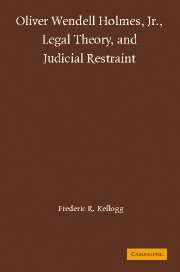Book contents
- Frontmatter
- Contents
- Preface
- 1 A Time for Law
- 2 Playing King: Connections and Misconceptions
- 3 Holmes's Conception of Law
- 4 Common Law Theory Revisited
- 5 Holmes and Legal Classification
- 6 The General Theory of Liability
- 7 Morals and Skepticism in Law
- 8 Judges, Principles, and Policy
- 9 Common Law Constitutionalism
- 10 Holmes's Theory in Retrospect
- 11 Conclusion
- Appendix
- Bibliography
- Index
3 - Holmes's Conception of Law
Published online by Cambridge University Press: 24 July 2009
- Frontmatter
- Contents
- Preface
- 1 A Time for Law
- 2 Playing King: Connections and Misconceptions
- 3 Holmes's Conception of Law
- 4 Common Law Theory Revisited
- 5 Holmes and Legal Classification
- 6 The General Theory of Liability
- 7 Morals and Skepticism in Law
- 8 Judges, Principles, and Policy
- 9 Common Law Constitutionalism
- 10 Holmes's Theory in Retrospect
- 11 Conclusion
- Appendix
- Bibliography
- Index
Summary
It is the merit of the common law that it decides the case first and determines the principle afterwards.
O. W. Holmes, 1870Before tracing Holmes's intellectual path, which I do in the following chapters, I should highlight a broad distinction between common law conceptions and their more recent alternative, analytical legal positivism. John Dewey, the American philosopher much admired by Holmes, held that law is “through and through a social phenomenon” and that all legal theories should be judged as programs for action. Hence Dewey warned against use of the word “law” as a “single general term.” Law, he explained, must be viewed as intervening in the complex of other activities, and as itself a social process. Hence (in Dewey's words) “‘law’ cannot be set up as a separate entity, but can be discussed only in terms of the social conditions in which it arises and of what it concretely does there.”
This is a classic statement of law as boundaryless, endogenous, and embedded, as a social theorist might say, an “open system.” It emerges in part from, and is applicable to, common law. It is distinct in several crucial respects from the dominant vision of legal positivism, which sees law as fundamentally separate, exogenous, autonomous, acting on society rather than acting within. Both models are in some degree reflected in the current methodology of American law; yet the two are at odds. They imply a deep inconsistency in our corporate belief in what law is.
- Type
- Chapter
- Information
- Publisher: Cambridge University PressPrint publication year: 2006



